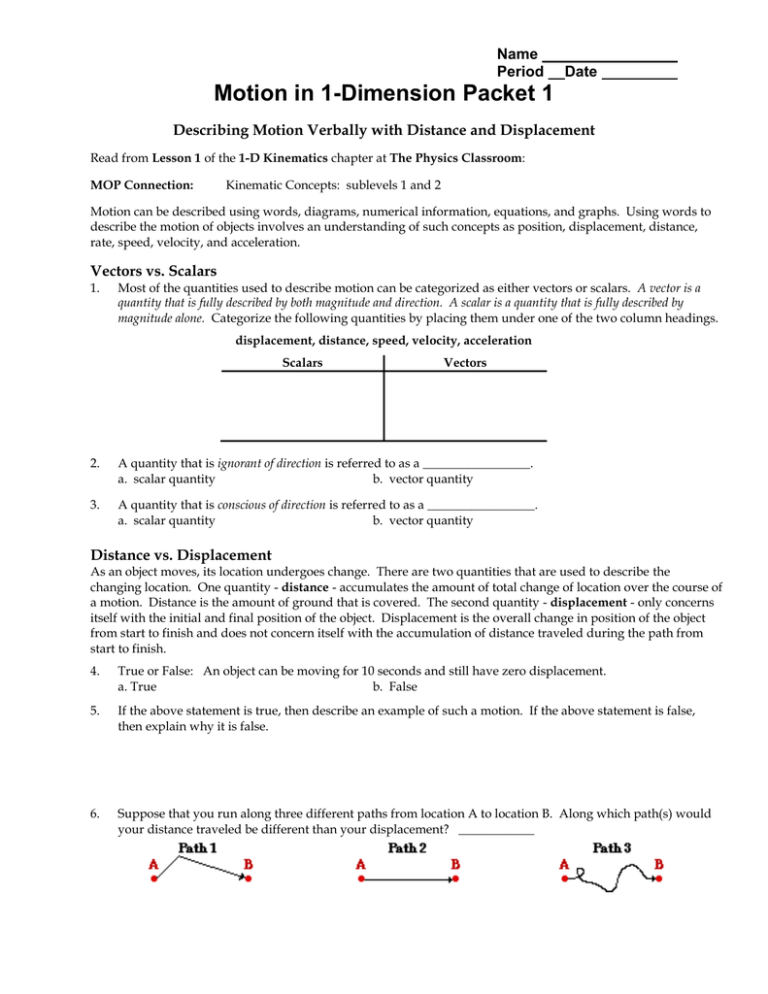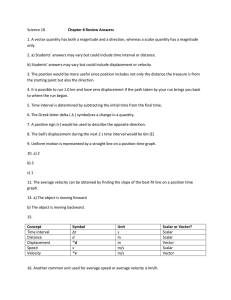Motion in 1-Dimension Packet 1 Name Period Date
advertisement

Name Period Date Motion in 1-Dimension Packet 1 Describing Motion Verbally with Distance and Displacement Read from Lesson 1 of the 1-D Kinematics chapter at The Physics Classroom: MOP Connection: Kinematic Concepts: sublevels 1 and 2 Motion can be described using words, diagrams, numerical information, equations, and graphs. Using words to describe the motion of objects involves an understanding of such concepts as position, displacement, distance, rate, speed, velocity, and acceleration. Vectors vs. Scalars 1. Most of the quantities used to describe motion can be categorized as either vectors or scalars. A vector is a quantity that is fully described by both magnitude and direction. A scalar is a quantity that is fully described by magnitude alone. Categorize the following quantities by placing them under one of the two column headings. displacement, distance, speed, velocity, acceleration Scalars Vectors 2. A quantity that is ignorant of direction is referred to as a _________________. a. scalar quantity b. vector quantity 3. A quantity that is conscious of direction is referred to as a _________________. a. scalar quantity b. vector quantity Distance vs. Displacement As an object moves, its location undergoes change. There are two quantities that are used to describe the changing location. One quantity - distance - accumulates the amount of total change of location over the course of a motion. Distance is the amount of ground that is covered. The second quantity - displacement - only concerns itself with the initial and final position of the object. Displacement is the overall change in position of the object from start to finish and does not concern itself with the accumulation of distance traveled during the path from start to finish. 4. True or False: An object can be moving for 10 seconds and still have zero displacement. a. True b. False 5. If the above statement is true, then describe an example of such a motion. If the above statement is false, then explain why it is false. 6. Suppose that you run along three different paths from location A to location B. Along which path(s) would your distance traveled be different than your displacement? ____________ Motion in 1-Dimension Packet 1 7. page 2 You run from your house to a friend's house that is 3 miles away. You then walk home. a. What distance did you travel? ______________ b. What was the displacement for the entire trip? _______________ Observe the diagram below. A person starts at A, walks along the bold path and finishes at B. Each square is 1 km along its edge. Use the diagram in answering the next two questions. 8. This person walks a distance of ________ km. 9. This person has a displacement of ________. a. 0 km b. 3 km c. 3 km, E d. 3 km, W e. 5 km f. 5 km, N g. 5 km, S h. 6 km i. 6 km, E j. 6 km, W k. 31 km l. 31 km, E m. 31 km, W n. None of these. 10. A cross-country skier moves from location A to location B to location C to location D. Each leg of the backand-forth motion takes 1 minute to complete; the total time is 3 minutes. (The unit is meters.) a. What is the distance traveled by the skier during the three minutes of recreation? b. What is the net displacement of the skier during the three minutes of recreation? c. What is the displacement during the second minute (from 1 min. to 2 min.)? d. What is the displacement during the third minute (from 2 min. to 3 min.)? © The Physics Classroom, 2009 Motion in 1-Dimension Packet 1 page 3 Describing Motion Verbally with Speed and Velocity Read from Lesson 1 of the 1-D Kinematics chapter at The Physics Classroom: MOP Connection: Kinematic Concepts: sublevels 3 and 6 Review: 1. A _________ quantity is completely described by magnitude alone. A _________ quantity is completely described by a magnitude with a direction. a. scalar, vector b. vector, scalar 2. Speed is a __________ quantity and velocity is a __________ quantity. a. scalar, vector b. vector, scalar Speed vs. Velocity Speed and velocity are two quantities in Physics that seem at first glance to have the same meaning. While related, they have distinctly different definitions. Knowing their definitions is critical to understanding the difference between them. Speed is a quantity that describes how fast or how slow an object is moving. Velocity is a quantity that is defined as the rate at which an object's position changes. 3. Suppose you are considering three different paths (A, B and C) between the same two locations. Along which path would you have to move with the greatest speed to arrive at the destination in the same amount of time? ____________ Explain. 4. True or False: It is possible for an object to move for 10 seconds at a high speed and end up with an average velocity of zero. a. True b. False 5. If the above statement is true, then describe an example of such a motion. If the above statement is false, then explain why it is false. 6. Suppose that you run for 10 seconds along three different paths. Rank the three paths from the lowest average speed to the greatest average speed. __________ Rank the three paths from the lowest average velocity to the greatest average velocity. __________ © The Physics Classroom, 2009 Motion in 1-Dimension Packet 1 page 4 Calculating Average Speed and Average Velocity The average speed of an object is the rate at which an object covers distance. The average velocity of an object is the rate at which an object changes its position. Thus, Ave. Speed = distance time Ave. Velocity = displacement time Speed, being a scalar, is dependent upon the scalar quantity distance. Velocity, being a vector, is dependent upon the vector quantity displacement. 7. 8. You run from your house to a friend's house that is 3 miles away in 30 minutes. You then immediately walk home, taking 1 hour on your return trip. a. What was the average speed (in mi/hr) for the entire trip? _______________ b. What was the average velocity (in mi/hr) for the entire trip? _______________ A cross-country skier moves from location A to location B to location C to location D. Each leg of the backand-forth motion takes 1 minute to complete; the total time is 3 minutes. The unit of length is meters. Calculate the average speed (in m/min) and the average velocity (in m/min) of the skier during the three minutes of recreation. PSYW Ave. Speed = © The Physics Classroom, 2009 Ave. Velocity = Motion in 1-Dimension Packet 1 page 5 Instantaneous Speed vs. Average Speed The instantaneous speed of an object is the speed that an object has at any given instant. When an object moves, it doesn't always move at a steady pace. As a result, the instantaneous speed is changing. For an automobile, the instantaneous speed is the speedometer reading. The average speed is simply the average of all the speedometer readings taken at regular intervals of time. Of course, the easier way to determine the average speed is to simply do a distance/time ratio. 9. Consider the data at the right for the first 10 minutes of a teacher's trip along the expressway to school. Determine ... a. ... the average speed (in mi/min) for the 10 minutes of motion. Time (min) Pos'n (mi) 0 0 1 0.4 2 0.8 3 1.3 4 2.1 5 2.5 6 2.7 7 3.8 8 5.0 9 6.4 10 7.6 b. ... an estimate of the maximum speed (in mi/min) based on the given data. 10. The graph below shows Donovan Bailey's split times for his 100-meter record breaking run in the Atlanta Olympics in 1996. a. At what point did he experience his greatest average speed for a 10 meter interval? Calculate this speed in m/s. PSYW b. What was his average speed (in m/s) for the overall race? PSYW © The Physics Classroom, 2009 Motion in 1-Dimension Packet 1 page 6 Problem-Solving: 11. Thirty years ago, police would check a highway for speeders by sending a helicopter up in the air and observing the time it would take for a car to travel between two wide lines placed 1/10th of a mile apart. On one occasion, a car was observed to take 7.2 seconds to travel this distance. a. How much time did it take the car to travel the distance in hours? b. What is the speed of the car in miles per hour? 12. The fastest trains are magnetically levitated above the rails to avoid friction (and are therefore called MagLev trains…cool, huh?). The fastest trains travel about 155 miles in a half an hour. What is their average speed in miles/hour? 13. In 1960, U.S. Air Force Captain Joseph Kittinger broke the records for the both the fastest and the longest sky dive…he fell an amazing 19.5 miles! (Cool facts: There is almost no air at that altitude, and he said that he almost didn’t feel like he was falling because there was no whistling from the wind or movement of his clothing through the air. The temperature at that altitude was 36 degrees Fahrenheit below zero!) His average speed while falling was 254 miles/hour. How much time did the dive last? 14. A hummingbird averages a speed of about 28 miles/hour (Cool facts: They visit up to 1000 flowers per day, and reach maximum speed while diving … up to 100 miles/hour!). Ruby-throated hummingbirds take a 2000 mile journey when they migrate, including a non-stop trip across Gulf of Mexico in which they fly for 18 hours straight! How far is the trip across the Gulf of Mexico? © The Physics Classroom, 2009





